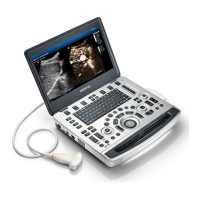6 - 28 Operator’s Manual
6 Image Acquisition
6 R-VQS (RF-data based quantification on arterial stiffness) values (6 cardiac cycles are
calculated in total), standard deviation SD and ROI length will be displayed in the result
window on the left.
4. Adjust parameters.
– Speed: Adjust refresh speed of vessel wall motion curve.
– Position: Adjust the location of the motion curve upwards and downwards.
– Curve Disp (Min)/Curve Disp (Max): Adjust amplitude of vessel wall motion curve.
5. Tap [Stop Calc] or press <Freeze> to freeze the image and stop updating motion curve and
result data.
6. Use the trackball to review the cine file and select desired frame.
– Tap [Accept Result] to update the result window data to the report.
Save the single-frame and multi-frame image if necessary.
– Tap [Cancel Result] to recalculate and perform step 3-5 if necessary.
7. Tap [Report] to check report.
Only the last result data will be saved.
If pressure is entered in the patient information page or the report page, Hardness coefficient
and PWV result will be displayed on the report.
For details about report operation, refer to "Advanced Volume".
6.12 Smart B-line
The lung acoustic impedance difference increases with the increase of lung liquids. The ultrasound
waves produce strong reverberations in the lung at different depth. After multiple reflections, the
comet tail sign is formed, which is perpendicular to the pleura plane. Starting from the pleura line,
the comet tail sign moves along with the lung and extends to the far field. The reverberation line
perpendicular to the pleura plane is called Smart B-line.
Smart B-line is used to detect the B line of the lung in B mode. It supports B-line detecting in both
real-time and freeze modes.

